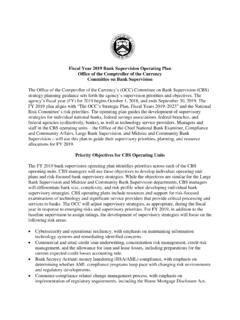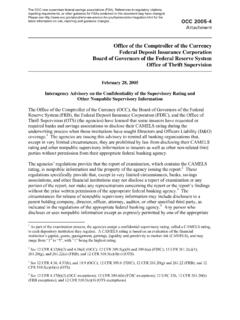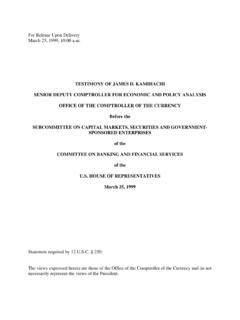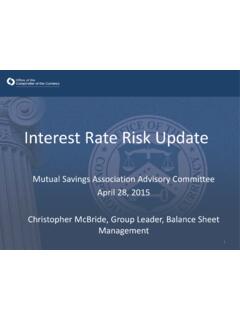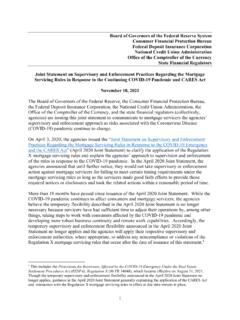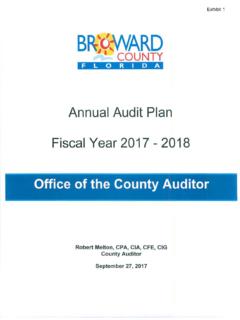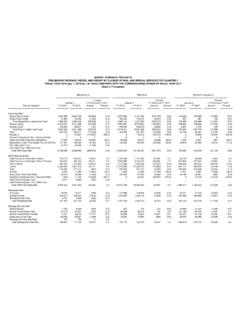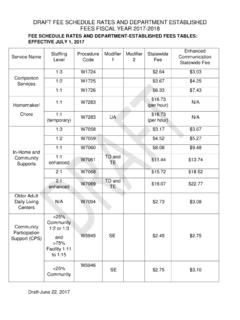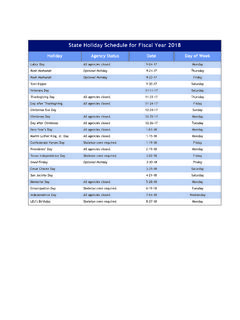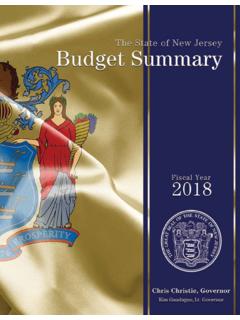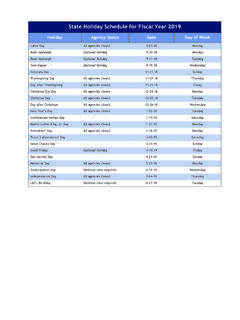Transcription of Office of the Comptroller of the Currency Committee on ...
1 fiscal year 2018 Bank Supervision Operating Plan Office of the Comptroller of the Currency Committee on Bank Supervision The Office of the Comptroller of the Currency s (OCC) Committee on Bank Supervision (CBS) annually develops an operating plan that sets forth the agency s supervision priorities and objectives. The agency s fiscal year (FY) for 2018 begins October 1, 2017 , and ends September 30, 2018 . The FY 2018 operating plan outlines the OCC s supervision priorities by operating unit and aligns with The OCC s Strategic Plan, fiscal Years 2015 2019, agency strategic priorities, and the National Risk Committee (NRC) risk priorities and actions. The operating plan guides the development of supervisory strategies for individual national banks, federal savings associations, federal branches, and federal agencies (collectively, banks), and service providers. Managers and staff in CBS operating units the Office of the Chief National Bank Examiner (CNBE), Compliance and Community Affairs (CCA), Large Bank Supervision (LBS), and Midsize and Community Bank Supervision (MCBS) will use this plan to guide their supervisory priorities, planning, and resource allocations for FY 2018 .
2 Priority Objectives for CBS Operating Units The FY 2018 bank supervision operating plan identifies priorities across each of the CBS operating units. CBS managers use these objectives to develop individual operating-unit plans and risk-focused supervisory strategies specific to the institutions they oversee. While the objectives are similar for operating units, CBS managers differentiate by bank size, complexity, and risk profile when developing supervisory strategies. CBS plans include resources and support for risk-focused examinations of service providers that provide critical processing and services to banks. The OCC adjusts supervisory strategies, as appropriate, throughout the year in response to emerging risks and evolving supervisory priorities. For FY 2018 , the development of supervisory strategies will focus on the following areas: Cybersecurity and operational resiliency Commercial and retail credit loan underwriting, concentration risk management, and the allowance for loan and lease losses Business model sustainability and viability and strategy changes Bank Secrecy Act/anti-money laundering (BSA/AML) compliance management Change management to address new regulatory requirements To facilitate an agency-wide view of risk on selected topics, the CBS operating units will prioritize and coordinate resources and conduct various horizontal risk assessments during the fiscal year .
3 The CBS units may direct horizontal assessments, as appropriate, during the supervisory cycle. fiscal year 2018 Bank Supervision Operating Plan 2 The OCC will provide periodic updates about supervisory priorities and horizontal risk assessments in the fall and spring editions of the Semiannual Risk Perspective. The following provides additional details on the strategy planning guidance for priorities within each CBS operating unit and for the NRC, which coordinates risk identification and analysis across CBS operating units. National Risk Committee The NRC serves as a central point of coordination for the agency s existing and emerging supervision and policy issues, including recommended actions to address such issues. NRC initiatives will focus on the following: Supervisory analytics: Gathering quantitative information across the OCC and the industry to support the identification and prioritization of risk facing the federal banking system.
4 Coordination: Incorporating frontline and expert perspectives on key supervisory initiatives, rulemakings, and guidance through operating unit and risk committees that regularly report to the NRC. Communication: Providing timely assessments to the industry and examiners about banking risks through the Semiannual Risk Perspective and other issuances. Horizontal risk analysis: Recommending, facilitating, informing, and reporting on horizontal initiatives, ensuring review findings are disseminated and incorporated, as appropriate, for consideration in future bank supervision strategies and agency policies. Standardized processes: Using and refining established documentation standards for consistent assessment of supervision risk by NRC and the agency. Effectiveness measures: Measuring effectiveness of actions taken in response to issues highlighted by the NRC and recommending adjustments. Resource alignment: Assessing planned and actual resource and budgetary allocations to key risk issues and reporting findings to CBS.
5 Large Bank Supervision The LBS Department will develop and execute individually approved FY 2018 supervisory strategies for each large bank, federal branch, and federal agency. Examiners will scope activities to maximize integration and prioritization of examination team resources across banks, and across risks and lines of business within banks. Examiners will incorporate assessments of audit and internal controls into the supervisory activities of each risk area. Supervisory strategies will cover, at a minimum, statutory requirements. Activities covering high and emerging risks will reflect a balance of horizontal and bank-specific supervisory objectives. Each strategy will incorporate the following, based on strategy guidance from the Large Bank Risk Committee that is customized for each bank s risk profile and results of prior supervisory activities: Matters requiring attention and enforcement actions: Ensuring banks remediate matters requiring attention and enforcement actions on a timely basis and in a manner that considers regulatory guidance and complies with laws, rules, and regulations.
6 fiscal year 2018 Bank Supervision Operating Plan 3 Horizontal risk analysis: Conducting horizontal risk assessments of shared national credits and Dodd Frank Act1 stress testing. Participating in CBS-, NRC-, or MCBS-directed horizontal initiatives. Seeking examination efficiencies and training opportunities by incorporating core supervision focal points into select horizontal initiatives. Governance and operational risk: Reviewing banks oversight of new products and services processes, fraud prevention, data governance, information technology strategy and budget, information security, payment systems risk, mobile products and services, and incorporation of Dodd Frank Act stress testing into risk appetite and strategic planning processes. Credit: Evaluating the effect of changes in underwriting practices on new or renewed loans such as easing in structure and terms and risk layering. Assessing lending to funds, the credit risk review function, commercial real estate risk management, portfolio stress testing, core mortgage servicing functions, default management, and retail credit-related third-party risk management.
7 Allowance for loan and lease losses: Assessing appropriateness of the allowance for loan and lease losses considering changes in underwriting standards, increased risk layering, and preparedness for the current expected credit losses accounting rule. Market risk: Reviewing compliance and risk management practices related to new or changing regulations such as the Volcker Rule, swap margin rule, liquidity coverage ratio, and net stable funding ratio. Examiners will evaluate how banks assess the risks of new or modified on- or off-balance-sheet products, services, and growth strategies designed to enhance profitability in the face of a prolonged low interest rate environment and other economic and competitive pressures. Supervisory staff will assess bank conflicts of interest and central counterparty risk management. As appropriate, examiners will consult and coordinate on supervisory strategies with other agencies, primarily the Board of Governors of the Federal Reserve System (Federal Reserve), Federal Deposit Insurance Corporation (FDIC), Securities and Exchange Commission (SEC), Commodity Futures Trading Commission (CFTC), and the Consumer Financial Protection Bureau (CFPB).
8 Midsize and Community Bank Supervision The MCBS Department will develop and execute supervisory strategies for each bank. Supervisory strategies will focus on key risks, achieving supervisory objectives, and effectively using OCC resources. MCBS will focus on: Credit underwriting: Evaluating underwriting practices on new or renewed loans for easing in structure and terms, increased risk layering, and potential fair lending implications. Reviews will focus on new products, areas of highest growth, and portfolios that represent concentrations, such as commercial and industrial, commercial real estate, agriculture, and auto loans. Examiners will assess concentration risk management practices, especially in those portfolios. Examiners will assess loan servicing, problem loan workout, collateral valuation, and spillover impact from low oil prices in relevant geographies. 1 The Dodd Frank Wall Street Reform and Consumer Protection Act was signed into law on July 21, 2010.
9 fiscal year 2018 Bank Supervision Operating Plan 4 Strategic risk: Evaluating changes in business models, short- and long-term strategies, and products and services designed to enhance profitability given the interest rate environment and other economic and competitive pressures. Examiners will review banks strategic plans to determine operating results in a range of rate environments. Operational risk: Assessing information security, data protection, and third-party risk management, including risks associated with third-party Examiners will review banks programs to determine to what extent they assess the evolving cyber threat environment and banks cyber resilience. Examiners will continue to use the Federal Financial Institutions Examination Council s Cybersecurity Assessment Tool and follow up on any gaps identified at banks in FY 2017 . Examiners will assess the systems development life cycle, user access rights, system resiliency, and user awareness programs.
10 In addition, examiners will evaluate bank management s plans to respond to increasing operational risk resulting from introducing new or revised business products, processing platforms, delivery channels, or third-party relationships, including outsourcing providers. Change management plans should be evaluated relative to regulatory, consumer compliance, and accounting changes that became, or will become effective in 2017 and 2018 . Examiners will assess enterprise data governance, including vendor and third-party management, which typically influences systems capacity, testing, security, sharing, monitoring, and retention. Market risk: Evaluating interest rate risk management, including the ability to identify and quantify interest rate risk in assets and liabilities under varying scenarios. Key focal points include assessing ranges of interest rate scenarios, including exposure to prolonged low rates, risk from a significant rapid increase in rates, and changes in the shape or slope of the yield curve.
